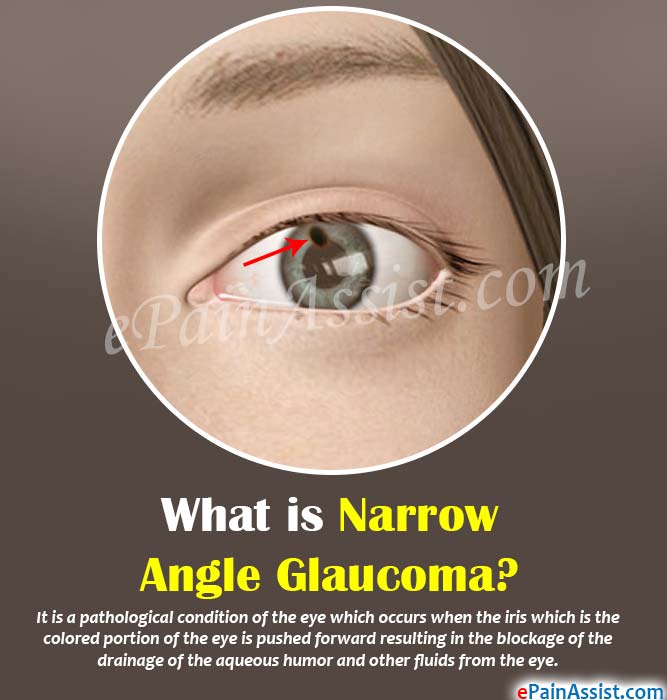What is Narrow Angle Glaucoma?
Narrow Angle Glaucoma is a pathological condition of the eye which occurs when the iris which is the colored portion of the eye is pushed forward resulting in the blockage of the drainage of the aqueous humor and other fluids from the eye. This results in increased intraocular pressure due to accumulation of fluids within the eye and tends to damage the optic nerve. Once the optic nerve is damaged, the eye is not able to send clear images of objects to the brain and the affected individual is not able to see things properly.
Narrow Angle Glaucoma is an emergent condition as if it remains untreated it may result in blindness within hours due to increased intraocular pressure. Some of the symptoms of Narrow Angle Glaucoma are eye pain, redness of the eye, headaches, halos around the eyes, dilated pupils, and loss of vision or blurry vision.

Additionally, nausea and vomiting may also occur. These symptoms may persist till the intraocular pressure comes down to acceptable limits. This is a condition which is recurrent and with every attack a part of the peripheral vision is lost due to Narrow Angle Glaucoma.
What are the Causes of Narrow Angle Glaucoma?
Some of the causes for Narrow Angle Glaucoma are:
Pupillary Blockage
The aqueous humor which is a fluid in the eye which keeps the eye wet and lubricated is produced in the ciliary body in the eye. This ciliary body is located behind the iris or the colored portion of the eye.
Under normal circumstances, the fluid flow easily through the pupils and drains out of the body through the drainage angle or channel present in the eye.
In Narrow Angle Glaucoma what happens is that, the iris gets stuck to the lens and thus the channel through which fluid passes through the pupils gets blocked resulting in the fluid getting pushed backwards. This leads to accumulation of fluids and makes the iris push outward. This causes the drainage angle to close causing the symptoms of Narrow Angle Glaucoma.
Iris Plateau
This is a condition in which the iris is attached to the ciliary body too close to the drainage channel. During dilation of the pupils the iris covers up the drainage channel completely causing sudden increase in intraocular pressure resulting in Narrow Angle Glaucoma. This type of Narrow Angle Glaucoma attack usually happens to people while they are in dim lights or when certain eyedrops are used to enlarge the pupil for an eye examination.
Hyperopia
This is also a condition which puts an individual at risk for having Narrow Angle Glaucoma, as people with this condition tend to have narrow drain which does not allow free flow of the fluids through these drains causing Narrow Angle Glaucoma.
Tumors
A tumor or swelling as a result of inflammation of the ciliary body may also cause Narrow Angle Glaucoma. Additionally, surgery done for a detached retina is also one of the causative factors for development of Narrow Angle Glaucoma.
What are the Symptoms of Narrow Angle Glaucoma?
As stated above, the main symptoms of Narrow Angle Glaucoma are pain and redness of the eye, blurred vision, and in some cases nausea and vomiting. These symptoms resolve when the intraocular pressure comes down but recur again when the pressure goes up. Additionally, the affected individual may see halos around the eye region due to Narrow Angle Glaucoma.
How is Narrow Angle Glaucoma Treated?
Narrow Angle Glaucoma is an emergent medical condition and needs to be treated as soon as possible since any delay in treatment may result in the affected individual losing his or her eyesight permanently due to Narrow Angle Glaucoma.
The main aim of treatment for Narrow Angle Glaucoma is to reduce the intraocular pressure. This can be done both with medications as well as through laser therapy. The medications given for treatment of Narrow Angle Glaucoma may be taken orally or in some acute cases are given intravenously.
Topical eyedrops to reduce the pressure are also recommended to treat Narrow Angle Glaucoma.
Laser therapy is the most preferred therapy for treatment of Narrow Angle Glaucoma. In this procedure, a small drain is created in the iris using laser beams through which the fluid may drain and the intraocular pressure is decreased. This hole is extremely small microscopic in size and the procedure is painless and can be done in an office setting. This is by far the most successful and preferred treatment for Narrow Angle Glaucoma.
It should be noted that Narrow Angle Glaucoma can be caused by anything that causes dilation of pupils so the individual needs to avoid any dim lights, medications which may dilate the pupil, any antihistamine or decongestant as they may all lead to Narrow Angle Glaucoma.
- American Academy of Ophthalmology. “Angle-Closure Glaucoma (Narrow-Angle Glaucoma).” https://www.aao.org/eye-health/diseases/angle-closure-glaucoma-narrow-angle-glaucoma
- Glaucoma Research Foundation. “Narrow Angle Glaucoma.” https://www.glaucoma.org/glaucoma/narrow-angle-glaucoma.php
Also Read:
